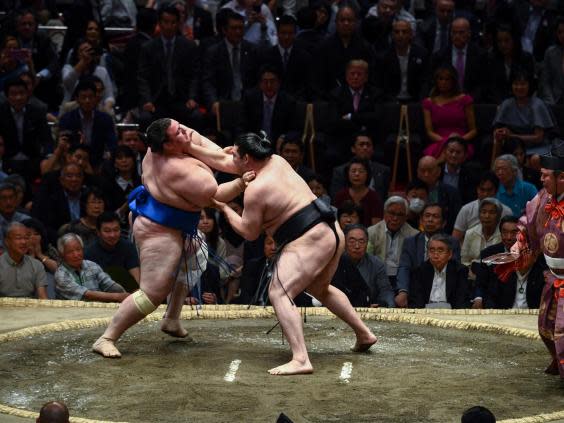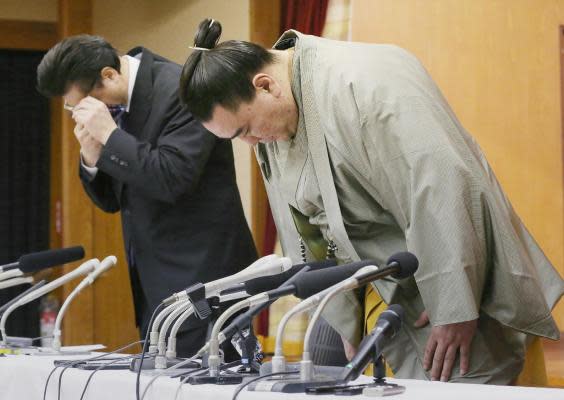Violence, corruption and concussion: The dark side to sumo wrestling – and why its popularity endures

The initial collision is seismic. The sumo wrestlers, crouched down in the centre of the ring, knuckles pressed into the sand beneath, launch forward in an explosion of rippling muscle and flesh. It’s a move the they practice for hours on end, honing the direction of that first impact, where to place their arms, whether to target the gut, chest or throat. Once contact is made, the giants rise up in a shaking embrace as they attempt to engineer a dominant position for themselves. Forearms are thrown, rolls of fat snatched at, dust kicked up as the two sets of feet make dance. Eventually it’s the smaller wrestler who emerges on top, inviting his rival to step forward before using his momentum to throw him out of the ring.
The fight, lasting little longer than 30 seconds, is over. The savage, violent brutalism is gone. In its place, an absorbing display of ritualised pageantry, both men bowing courtly to the crowds before the process starts over for the next tussle. The solemn recitations. The throwing of salt to purify the ring. The slapping of arms, legs and stomachs – demonstrations to prove the wrestlers are unarmed. And then, at last, the breathless eruption of violence. Sat cross-legged and shoeless in the lower levels of Tokyo’s Ryōgoku Kokugika, a squat, 11,000 seat arena nestled away in the east of the city, there’s a mesmeric quality to the experience, one that drags you back in time to the sport’s ancient past.
Because, unlike any other mainstream sport in Japan, sumo wrestling remains deeply wedded to its roots. The same set of rules and rites which applied when matches were performed in the Japanese Imperial courts, as far back as the eighth century, continue to influence today’s proceedings. How exactly sumo started, historians are unsure. But links have been made to harvest rituals associated with the Shinto religion. That legacy can be seen in the use of salt purification and the stylised, shrine-like roof which covers the ring. “It’s literally frozen in time,” says John Gunning, a sumo columnist for the Japan Times.
In many ways, sumo is more than just a sporting spectacle. “It’s a lifestyle,” says Jeff, a sumo ticket-seller and avid fan. “It’s a religion, it’s a cultural treasure. The sport has a mandate as a social and culture treasure that needs to be protected, preserved and carried forward – hence why the Japanese government [the Ministry of Education] supports the Sumo Association.”
As a “lifestyle”, sumo is all-consuming. Those who dedicate themselves to the sport are expected to train and live in shared stables, run by a ‘stablemaster’, until the point of retirement. No last-minute transfers, no loans. That’s it. Waking up at around 6am, wrestlers will spend hours each day perfecting moves and grapples. Driving is not permitted – a status symbol and out of necessity, given their size. Younger apprentices are required to clean, cook and perform endless tasks for their elders. About 97 per cent of fighters are not paid, although accommodation and food is provided. Even mobile phones and girlfriends are technically banned below divisions 1 and 2, the sekitori ranks, though some leniency is creeping in. “It’s a 24/7 thing, you’re never not a rikishi [sumo wrestler],” says Gunning.
The life of the sumo makes for a fascinating window through which to gaze into a part of Japan’s history that many feel has been lost. But for all its mystic appeal, the sport’s cultural and social “mandate” has repeatedly set it on a collision course with controversy. The need to “preserve” and “protect” has, at times, taken precedent over the need to modernise, leaving sumo unmistakably out of touch with its surroundings.
Within the stables themselves, sumo’s rigid rules and hierarchy have created a culture in which hazing and bullying can take root. The scandals have come thick and fast over the years. Only last month, one wrestler was suspended from the September basho, or Grand Tournament, while the Japan Sumo Association (JSA) investigated reports he had assaulted an attendant at his stable. Two years prior, Harumafuji, a former sumo grand champion, known as a yokozuna, retired after attacking a younger wrestler in a bar and fracturing the man’s skull.
That incident threw sumo back to the darks days of 2007, when a 17-year-old trainee died after three wrestlers, under instruction from their stablemaster, beat the youngster with a beer bottle and a baseball bat. The stablemaster was sentenced to six years imprisonment for manslaughter while his three elders were also charged. It was a moment that shocked the sport, pointing to a sinister culture that hadn’t previously been exposed.

Lee Thompson, a professor of sports science at Waseda University, sees sumo’s violent side as a byproduct of wider society. “Violence has been part of hierarchical relationships in Japan for much of the modern era,” he says, “but now it is getting called out – and not just in sumo.” Others, though, see it as more localised. One insider told The Independent that stable environments can be “toxic”, dominated by aggressive, testosterone-fuelled young men who are often poorly educated. “It’s like Lord of the Flies,” he said. “Sumo has created an insular society that doesn’t recognise and respect outside authority – it’s lawless.”
This mentality has left sumo equally susceptible to corruption down the years. After a lengthy police investigation, and having initially denied the allegations, the JSA admitted in 2011 that the sport had been subject to widespread match-fixing, with 13 senior wrestlers implicated. Links with the criminal underworld have also been uncovered. In 2010 the JSA suspended 18 fighters and banned one stablemaster for betting on baseball games in a gambling ring run by the yakuza.
Sumo’s attitude towards women has similarly reinforced the perception of an out-of-touch sport. Women aren’t allowed to compete, nor permitted to enter the ring. Last year, this particular rule left officials red-faced when two female nurses were scolded for rushing into the dohyō to help a mayor who had collapsed while giving a talk at a sumo event in the Kyoto Prefecture. An apology was later made to the women but it demonstrated the sport’s rigidity in adhering to its backward values. “The absurdity is obvious, but I don’t believe the issue will be fixed anytime soon,” says Shotaro Moore, a writer and sports blogger.

Then there’s the topic of concussion, an issue that has yet to be confronted. Compared to the likes of American football and rugby union, sumo is light years behind. One source told The Independent he has repeatedly seen “clearly concussed” wrestlers, who have been indoctrinated with the mentality of “simply getting on with it”, swerve medical care in the wake of fights.
“It’s going to be a huge issue,” says Gunning, who, as a former amateur wrestler, understands the inherent dangers. “There’s no sparring in sumo. You fight at full pace and speed. So you’re cracking heads – you get that coconut sound – again and again, 100s of times a day. You can see it in the older guys. Violent mood swings. Forgetfulness. All the same things the old footballers have.” He adds that there’s no been willingness from the authorities to tackle the issue as it “hasn’t reached the public consciousness here”.
As Japanese society has grown and modernised, it only feels right that a sport with so many shortcomings should find itself under the spotlight. “There are aspects of sumo that have become a difficult fit for modern life,” says Gunning. But whether sumo is prepared to evolve for the sake of aligning itself with society remains to be seen. Advocates argue it is already adept at modernising, pointing to the fact it has had video-assisted refereeing since 1969, but on more pressing issues – the misogyny, the clandestine violence – progress seems unlikely. “It’s a lot better than it used to be in most ways,” adds Gunning, but he insists that the “antiquated” argument of “it was OK in the past so it’s OK now” is wafer-thin.

Is sumo therefore in danger of distancing itself from Japan’s youthful, more progressive population? There are certainly some concerns of what the future holds, especially when the influence of today’s digital age and competition from more enlightened, more modernised rival sports are taken into account. Equally, the conditions which have historically driven men towards sumo no longer exist. Long gone are the days when the security and shelter of stable life would draw in impoverished, hungry men from large rural families.
But in spite of all of this, sumo has something which its rivals don’t. “It’s distinctly Japanese,” says Moore. The fierce attachment to its history – including the good, the bad, the ugly – continues to sustain the sport. “In a nutshell, it represents tradition, it literally puts it on display,” Thompson says. “This is a large component of its popularity at home, where most of the population don’t have much contact anymore with that kind of tradition.”
With the scandal-hit years of 2007-2011 a thing of the past, it feels like the sport has recaptured the public imagination. “It’s more popular now than it’s ever been,” says Gunning. Tickets for the six bashos, around 170,000 in total, are known to sell out in 45 minutes. The JSA is also facing endless requests to bring its domestic tours to towns up and down the country.
The ascension of Japan’s star Kisenosato to champion yokozuna status in 2017, ending a 10-year dry spell for the country, will have equally helped drive engagement. So too the JSA’s improved marketing efforts, having developed a social media presence for the sport, introduced an english-speaking website and stopped tours abroad to nurture interest at home. This revival in popularity has coincided with a surge in tourism numbers, with 31 million visitors to the country in 2018. A quintessential Japanese experience, sumo is often a ‘must-see’ sight for curious travellers, “presenting a comfortably exotic image” of the country, says Thompson.
As the lines of modern culture become blurred and greyed under the endless, ubiquitous slosh of globalisation, sumo stands aside as something different – for better and for worse. But as long as the sport continues to embrace its past, in all its mysterious, complicated, alluring forms, it seems there will always be an appetite for this ancient way of life.
Read more
Trump presents trophy to sumo wrestling champion on Japan visit

 Yahoo Sport
Yahoo Sport 





































